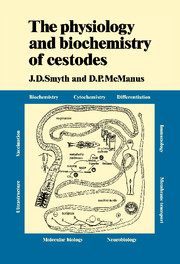Book contents
- Frontmatter
- Contents
- Preface
- Acknowledgements
- 1 The cestodes: general considerations
- 2 The adult cestode: special structural features relevant to its physiology
- 3 The adult cestode in its environment
- 4 The adult: general metabolism and chemical composition; lipid metabolism
- 5 The adult: carbohydrate metabolism
- 6 The adult: proteins and nucleic acids
- 7 The biology of the egg
- 8 Developmental biology of larvae
- 9 Development within definitive host
- 10 Cultivation of cestodes in vitro
- 11 Immunobiology of cestodes
- References
- Index
3 - The adult cestode in its environment
Published online by Cambridge University Press: 24 November 2009
- Frontmatter
- Contents
- Preface
- Acknowledgements
- 1 The cestodes: general considerations
- 2 The adult cestode: special structural features relevant to its physiology
- 3 The adult cestode in its environment
- 4 The adult: general metabolism and chemical composition; lipid metabolism
- 5 The adult: carbohydrate metabolism
- 6 The adult: proteins and nucleic acids
- 7 The biology of the egg
- 8 Developmental biology of larvae
- 9 Development within definitive host
- 10 Cultivation of cestodes in vitro
- 11 Immunobiology of cestodes
- References
- Index
Summary
General considerations
Cestodes differ from trematodes and nematodes in that the adults, with a few exceptions, occupy one type of habitat – the alimentary canal. Even the exceptions occur in sites related to the gut. Examples of some aberrant genera are: Stilesia, Thysanosoma (bile ducts of sheep), Porogynia (bile ducts of guinea fowl), Atriotaenia (pancreatic ducts of Nasua), Progamotaenia and Hepatotaenia (bile ducts, gall bladder and liver of marsupials). Hymenolepis microstoma, which is found in the bile ducts of rodents, is widely used as a laboratory model (446).
An understanding of the physiology and morphology of the alimentary canal is thus of particular importance to the study of cestode physiology. Knowledge in this field has expanded greatly within recent years and a number of valuable reviews are available (161,213,370,507,602, 730,970). The alimentary canal, considered specifically as an environment for parasitic helminths, has also been reviewed (54,56,157,527,530). The immune responses of the gut are reviewed in Chapter 11 and it must be emphasised that, as a result of these responses, the structure and function of the intestine can undergo profound changes when infected with cestodes (Table 3.1).
The alimentary canal as a biotope
Intestinal parameters
MORPHOLOGY
It is not intended to give here a detailed description of the vertebrate alimentary canal, accounts of which are given in the reviews referred to above.
- Type
- Chapter
- Information
- The Physiology and Biochemistry of Cestodes , pp. 35 - 52Publisher: Cambridge University PressPrint publication year: 1989
- 1
- Cited by



